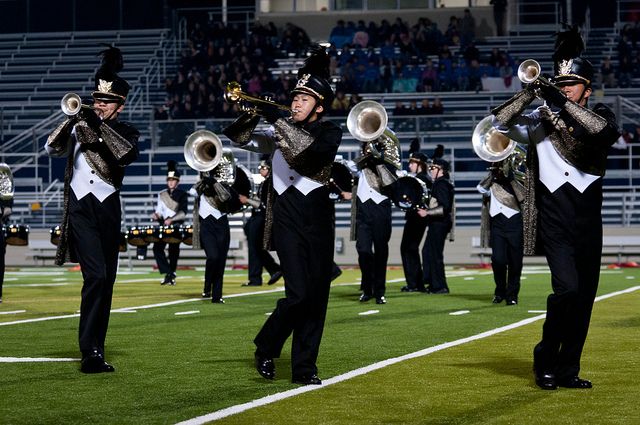
[dt_button link=”http://d165vjqq8ey7jy.cloudfront.net/mp3/33077/se-8242s.mp3″ target_blank=”true” button_alignment=”default” animation=”fadeIn” size=”small” style=”default” bg_color_style=”custom” bg_color=”#333333″ bg_hover_color_style=”custom” bg_hover_color=”#444444″ text_color_style=”custom” text_color=”#ffffff” text_hover_color_style=”custom” text_hover_color=”#dddddd” icon=”fa fa-cloud-download” icon_align=”left”]Yuklash[/dt_button]
[dt_divider style=”thin” /]
Music for Marching
Voice 1
Welcome to Spotlight. I’m Adam Navis.
Voice 2
And I’m Liz Waid. Spotlight uses a special English method of broadcasting. It is easier for people to understand, no matter where in the world they live.
Voice 1
Music can move us. It can make us want to dance. It can put us to sleep. It can inspire us. But what about this music? What does this music make you think about? Does it make you want to get up and walk around? That is what it is designed to do. This form of music is called a march. Marches began as military music. But they have become something much more. Today’s Spotlight is on the music of the march.
Voice 2
Military leaders have known for a long time that music is good way to communicate with soldiers. For example, in the United States, the Army uses trumpets to tell soldiers what to do. For example, this is the music that tells soldiers to get up in the morning. This is the music that tells them it is time to sleep.
Voice 1
Marches started as a way to help soldiers move from one place to another. Musical Marches got their name from the rhythmic marching of soldiers. Marches have a regular beat. They often include musical instruments like horns, drums, and flutes.
Voice 2
People wrote the first marches during the 1800s. They became popular in the Ottoman Empire. Today this is the country of Turkey. But marches were not only used in battle. Every time there was a new leader of the Ottoman Empire, a musician wrote a new march in his honor.
Voice 1
Turkish marches influenced many great music writers. Mozart, Hayden, and Beethoven all wrote marches. Military bands did not perform these marches. Instead, they were performed by professional orchestras in great concert halls.
Voice 2
But one person has defined the modern march more than any other. His name is John Philip Sousa. Here is one of Sousa’s most famous marches, called “Stars and Stripes Forever”. It is the official march of the United States.
Voice 1
Sousa was born in 1854. This was around the time of the civil war in the United States. Sousa grew up in Washington D.C., the capital city of the U.S. There many soldiers there. All these soldiers needed many musical bands to help them march. Sousa learned a lot by watching these musicians. And when he was 13 years old, Sousa joined the Marine Corps Band. He did not fight. But he played a lot of music – especially marches.
Voice 2
When Sousa became an adult, he left the Marine Corps Band. But he continued to write and play marches. He traveled from city to city playing music. Sousa became very famous. Years later he was invited to return to the Marine Corps Band. But it was not as a player — it was as the leader of the band! There, he wrote this song, called “Semper Fidelis”. It is the official march of the US Marines
Voice 1
Today, Sousa’s music continues to define the march. It shapes other music, from rap to pop and country. And without Sousa we would probably not have modern marching band competitions. This is a marching band competition:
Voice 2
In this competition, several schools’ marching bands compete against each other. Marching band competitions take place on an American-style football field. The bands include from 50 to over 400 people. People in the band all wear the same clothes. They wear a uniform representing their school.
Voice 1
The marching bands begin by marching onto the field. They usually do this to a single drum. They each hold their instrument. They form a line across the field in a starting shape or formation. Then the music begins. The music they play is similar to marches of the past. There are drums, horns, cymbals, and flutes.
Voice 2
But the marching band does not march in a straight line. They move around the field. Some people go one way, some people go another way. Each player knows exactly where he or she needs to be. If even one person is out of place, other players will crash into them. The band moves from one complex formation into another. Sometimes these formations create pictures. Sometimes they create words.
Voice 1
Another difference between marches of the past and modern competitions is the music. The music is still a march. It still has a strong drum beat and loud horns. But very few bands use the music of Sousa. They change modern music into a march style. Bands have used songs like Psy’s “Gangnam Style,” Adele’s “Hello” and “Uptown Funk” by Mark Ronson, featuring Bruno Mars. There is also usually a time when all the instruments stop, except for the drums. This is called the drumline. It is fun to watch.
Voice 2
Being part of a marching band requires a lot of time and energy. If one person misses a performance, their position will be empty. Being in a marching band teaches people a lot of things. It is hard work. It takes a lot of time. Members of the band learn to depend on other people and work together. They must be physically strong. And they must be intelligent. Marching band musicians must be able to do many different things at the same time.
Voice 1
The march may not be the most popular form of music. But people who compete in marching bands love it. The military does not use marches as much as they did in the past. There are other ways to move soldiers from one place to another. But that is a good thing. After all, using marching music to compete with another school is a much more pleasant way to compete!
Voice 2
What about you? Have you ever played in a marching band? Does your country have a military band? You can leave a comment on our website. Or email us at radio@radioenglish.net. You can also comment on Facebook at Facebook.com/spotlightradio.
Voice 1
The writer of this program was Adam Navis. The producer was Michio Ozaki. The voices you heard were from the United States. All quotes were adapted for this program and voiced by Spotlight. You can listen to this program again, and read it, on the internet at www.radioenglish.net. This program is called, ‘Music for Marching’.



